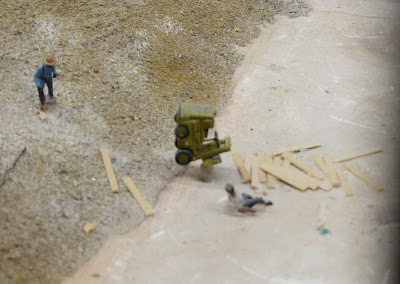The first thing one notices are the buildings and the people. I liked the smaller ones, the HO scale the best.
The lumber yard.
Out in back, some unfortunate lumber yard employee has driven his forklift down the embankment and plunged in to the river below. His load is spilled, and he sits in the water.
Here we are having drag races behind the rail yard.
The Tijuana station.
I don't know if you can see it, but inside of this church there are pews, an organ and someone playing the organ.
Working on the railroad.
The cities are really good.
This is a larger scaled city, O maybe. I forget, but doesn't it look good? The lights are LED.
In addition to historical accuracy in the buildings, there is some whimsy as well.
Notice the swimming pool.
"LED lighting is managed by four individual lighting circuits controlled by four independent microprocessors. Head light, tail light, top flashing light and turn signals all operate independently. Each circuit can be programmed for the length of the lighting period and the cycle time. This provides a high level of modeling effect for the LED lighting." Text from the museum.
The Carrizo Gorge railway took 12 years to build and included construction of 17 tunnels and 14 major wooden trestles, including the spectacular Goat Canyon Trestle. It was completed in 1919. The trestle is made out of redwood, is 200 feet tall and 750 feet long. Over the years there have been cave-ins, and other disasters. At one point the Southern Pacific petitioned to abandon the rail line. It was not abandoned and in 2004 the San Diego and Eastern Railway rehabbed the line to carry sand. Trains are still running on this, as well as mountain bikers who know the train schedule very well.
Look at the model. That was assembled out of lots of teeny tiny pieces of wood.
Here is the railway over the Tehachapi Pass. "Surveying southeast from Bakersfield in 1874, civil engineers planning the rail route over Tehachapi were stymied when they reached Caliente. There seemed to be no suitable route through the mountains that would take them over the summit of the Sierra Nevada. Chief Engineer William Hood then surveyed a line down from the summit of Tehachapi Pass. It included a 360-degree spiral loop, seventeen tunnels, and six horseshoe curves including the one at Caliente. The line over Tehachapi pass was completed in 1876." Text is from on of their explanatory signs. This is the 360 from the air. The thing that boggles the mind is when these rail lines were built. There were no CAD packages, no laser sighted surveying equipment, none of that. There were guys out hundreds of miles from home on horseback plowing through the wilderness with a transit and a helper. People were tough back then.
Here is the modeled version.
Work on the museum continues. They have a lot of space yet to fill. They work from old photos.
They work from Google Earth.
More railways for the future.
I think model railroading is a combination of people liking to build stuff, paint stuff, a love of history and wiring. It doesn't interest me personally, but after this tour of the museum, I can understand the attraction of the hobby, especially when you have a basement this big.





















Wow!! That was outstanding!! Loved the shark in the pool!!
ReplyDeleteVery enjoyable. Thanks for sharing! I got an American Flyer train set for Christmas when I was a kid (around 1960 or so) and it probably was the most memorable Christmas gift I've ever received, before or since.
ReplyDelete